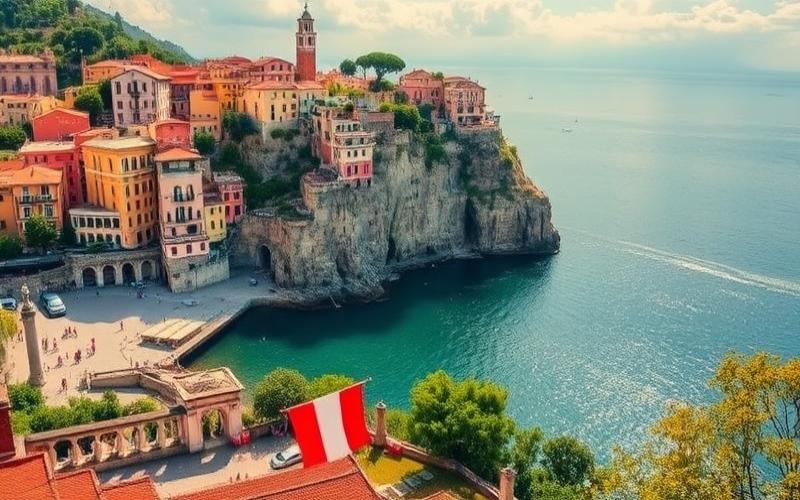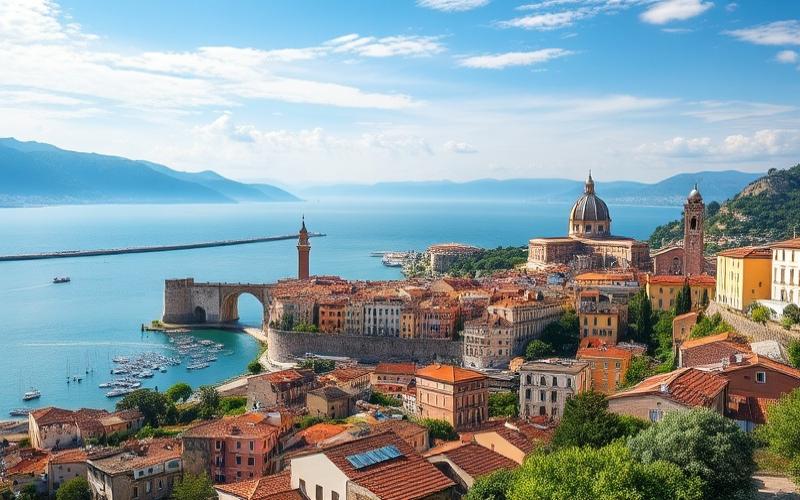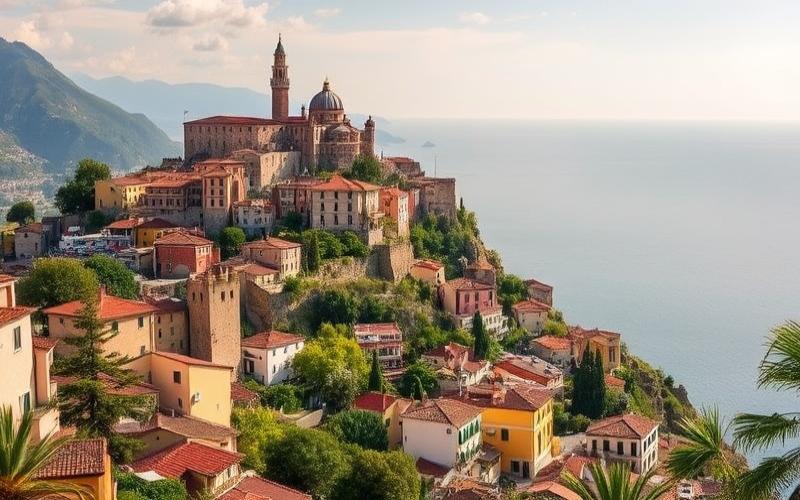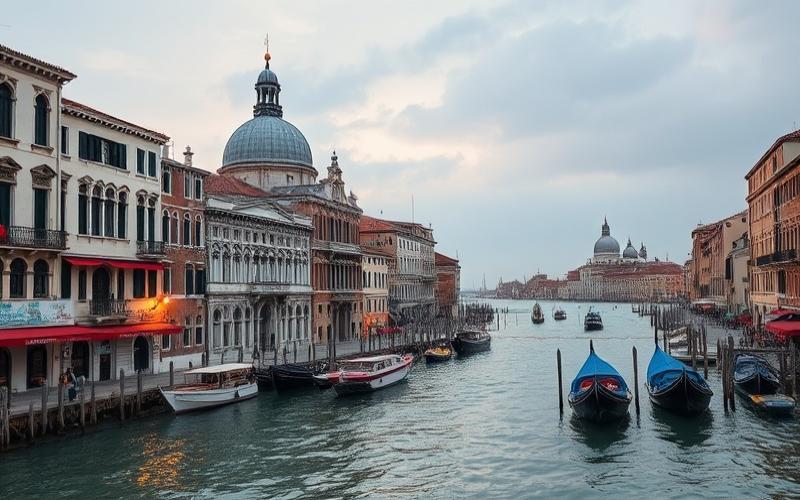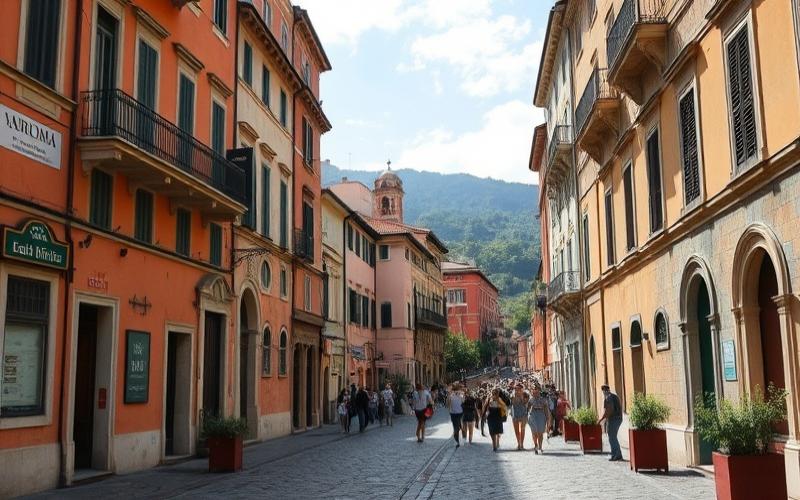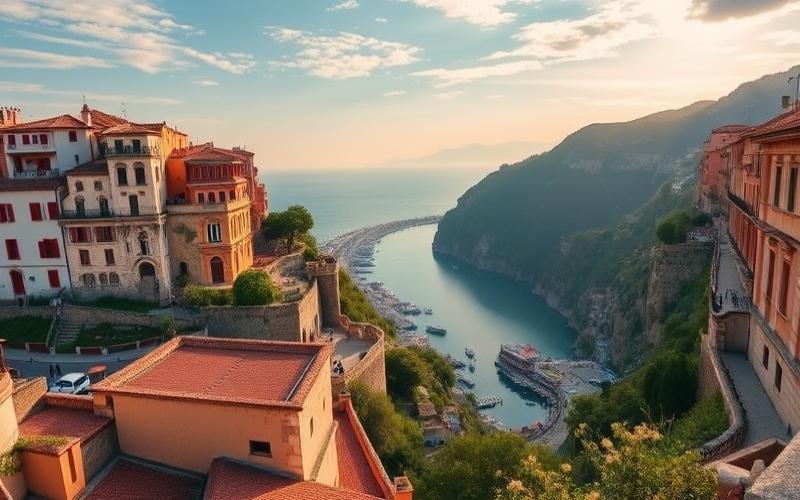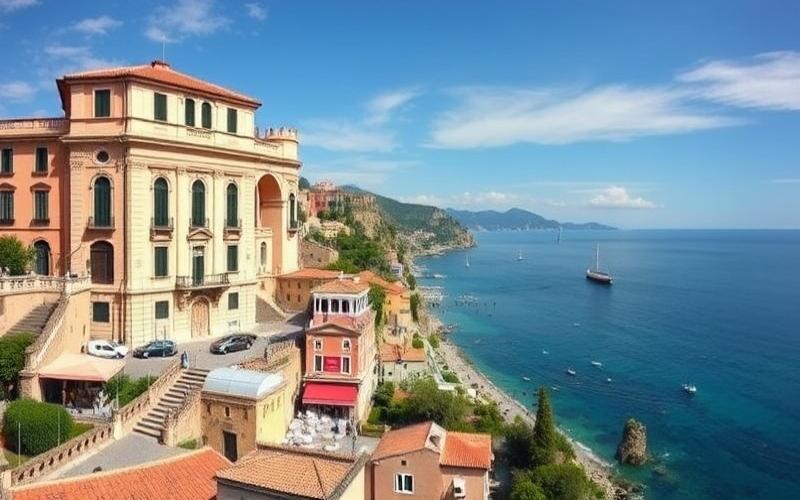
 Published on and written by Cyril Jarnias
Published on and written by Cyril Jarnias
While Italy is often celebrated for its rich cultural heritage and stunning landscapes, it’s now gaining attention for a notable economic development: rising real estate prices in some of its key cities. By 2030, investors and potential property buyers should seriously examine current trends, as these cities promise to become major hubs where price evolution could radically transform the real estate market.
Charismatic cities like Milan, Rome, and even lesser-known gems could hold significant surprises, mapping out an unprecedented picture of urban prosperity in Italy.
Promising Cities in Italy: Where to Invest in Real Estate by 2030
Italy’s most promising cities by 2030 combine solid economic growth, structural infrastructure projects, and favorable or clarified regulations/taxation, with distinct markets in Milan, Rome, Naples, and Florence, and complementary opportunities in Turin and art cities, driven by tourism and quality residential demand.
Macro Context and 2025-2030 Trends
Post-pandemic recovery with price stabilization in major cities, followed by moderate growth, supporting market entry at still attractive levels according to international real estate investment professionals.
Key factors to monitor: European economic stabilization, Italian fiscal policies, financing and interest rates, tourism recovery, energy transition and ESG criteria in buildings.
Dynamic demand in the luxury segment (Milan, Rome, Florence) and short-term rentals in tourist and business hubs, with sustained interest from international buyers.
Milan: Driving Hub and International Visibility
Approximately one-third of foreign real estate investments in Italy are concentrated in the Milan metropolitan area, driven by its European standing in finance, fashion, design, and tech.
2030 Trajectory: transformation into an international metropolis supported by major urban projects (business districts, redevelopments, mobility), strengthening rental attractiveness, including for short-term stays where local regulations remain more flexible than in other European metropolises.
Competitive positioning: Milan is progressing in international attractiveness rankings (PwC) and capturing a growing share of tourist and business flows, supporting rents and prime values.
Professional forecasts: moderate and sustained growth, premium on high-end segments and well-connected central areas, with potential for value appreciation in redevelopment zones.
Rome: Heritage Markets and Progressive Appreciation
The capital benefits from consistent international demand for high-end properties and structural tourism foundation, factors supporting the resilience of the heritage market.
2030 Dynamics: gradual improvement of urban infrastructure and transportation, with upside potential in rehabilitation neighborhoods and properties suited for flexible uses (coliving, medium-term furnished rentals).
Professionals: price stabilization followed by moderate growth, with preference for energy-renovated assets located on well-connected routes.
Naples: Regional Traction and Yield
Notable Southern exception: prices are more dynamic than in other southern regions, driven by the Campania area where Naples is the economic and logistic engine.
Investment advantages: competitive gross yields compared to the North, supported by tourism, local economy, and urban rental needs; relevant use cases for furnished rentals and value-add investment.
2030 Perspective: progressive upgrading of central and waterfront neighborhoods, opportunities in energy renovation and rehabilitation of historic buildings with high rental potential.
Florence: Heritage Value and High-End Tourism
Iconic art city: strong heritage value and sustained rental potential supported by quality international tourism, with demand supporting prices in historic districts.
2030 Trends: growth driven by the luxury segment and quality of life; opportunities in renovated and energy-efficient assets, and in medium/short-term rentals compliant with local regulations.
European comparison: Florence maintains competitive median pricing compared to some Western European capitals, while offering tourism depth comparable to major cultural cities.
Turin: Concrete Case of Redevelopment and Yield
Post-Olympic rehabilitation: renewed urban attractiveness, culture and sports, strengthening local economy and tourism.
Market data: average prices around €1,930/m² (range approx. €1,147–€3,492/m²), lower than Milan, with target rental yields of 6–7% according to rental market practitioners.
Rental demand supported by companies and universities; accessibility and connections with Milan and Genoa enhance attractiveness for residents and cross-border commuters.
Regulations and Taxation: Key Points to Watch
Depending on the market, Italian cities maintain greater flexibility for short-term rentals than some European metropolises, supporting yields in tourist and business districts; Milan is often cited for this competitive differential.
National and local fiscal policies (property taxation, incentives for energy renovation) remain major drivers of demand and valuations for 2025–2026, with expected ripple effects on greening the building stock.
For investors, energy compliance and ESG standards are becoming valuation criteria and financing access requirements, impacting pricing between renovated and to-be-renovated assets.
Infrastructure Projects and Redevelopments: Multiplier Effects
Milan: continuation of urban redevelopment programs and mobility extensions, fueling attractiveness for businesses and talent and supporting rent increases in new hubs.
Turin: sustainable urban transformation post-2006 with improved transportation and cultural offerings, strengthening residential and student demand.
Art cities: renovation of heritage buildings and energy standard upgrades, with increased valuation prospects in highly touristy central areas.
Comparison with Other European Cities
Relative attractiveness: Milan regularly ranks among Europe’s most attractive metropolises for investment, particularly in office and high-end residential segments, benefiting from entry costs still lower than peaks in Paris or London and favorable employment dynamics.
Pricing and yields: compared to Northern and Central Europe, Italy offers higher gross yields in secondary cities like Turin or Naples, with substantial price/m² differential, at the cost of higher macro volatility.
Tourism and heritage: Italian art cities (Florence, Venice) maintain seasonal rental potential and heritage value comparable to top cultural destinations in Europe, with median prices still competitive across markets.
What Professionals Say (Excerpts and Summary)
“Price stabilization followed by moderate growth in major cities, with sustained demand for luxury” (sector analysis from international investors).
“Target yields 6–7% in several major Northern cities, more affordable prices than Milan in Turin” (specialized operators and brokers).
“2025–2026 factors: fiscal policies, financing, tourism recovery, energy transition” (pan-European real estate advisors).
Comparative Table (2030 Potential, Residential Market Summary)
| City | Growth Potential | Target Yields | Key Drivers | Risks/Points to Watch |
|---|---|---|---|---|
| Milan | High | Moderate, premium on luxury | Redevelopments, business hubs, mobility, short-term rentals | Already high prices, micro-market selectivity |
| Rome | Moderate to High | Moderate | Heritage, tourism, energy upgrades | Neighborhood heterogeneity, administrative delays |
| Naples | Emerging | Superior | Tourism, regional logistics, value-add | Macro volatility, need for building stock renovation |
| Florence | High (heritage) | Moderate to good (seasonal) | Luxury, cultural tourism, renovation | Local rental regulations, tourism sensitivity |
| Turin | Solid | 6–7% | Students/companies, post-redevelopment | Lower liquidity than Milan, location selection |
Lists of Concrete Opportunities for Investors
- Shift towards renovated/eco-efficient assets in historic centers of Rome and Florence, to capture ESG premium and international demand.
- Value-add strategies in Naples and Turin: building redevelopment, coliving/student housing, managed furnished rentals, to target superior yields.
- In Milan, target transforming neighborhoods and products compatible with short-term rentals respecting local regulations, to optimize occupancy and revenue.
Good to Know:
Milan and Rome prove essential for real estate investments by 2030 thanks to significant infrastructure projects, like metro line extensions, and a dynamic business climate encouraged by attractive tax incentives. Florence, with its urban rehabilitation and growing positioning as a tech hub, offers substantial potential, while Naples attracts with its urban reforms and pronounced tourism growth, thus stimulating rental demand. According to experts, Milan is expected to see its real estate prices grow by 20% by the end of the decade, supported by innovation and startups, in line with trends observed in other European metropolises such as Barcelona. Recent measures promoting energy renovation in Italy add an ecological and economic dimension, enhancing attractiveness for investors concerned with sustainable development.
Trend Analysis: Long-Term Real Estate Forecasts in Italy
Long-term Italian real estate prices are expected to remain under moderate upward pressure, driven by sustained urban demand, credit recovery, and accelerated internationalization of demand, despite demographic headwinds and purchasing power constraints. Primary and intermediate markets already show moderate real increases, with robust rental dynamics supporting yields and valuations.
Structural Economic Factors
Growth and Credit Cycle
Transaction recovery in 2024 (+1.3% to 719,578 deeds) and marked rebound in financed purchases in Q4, signaling credit support for demand.
Rent increases (+3.4% year-over-year) strengthening investment attractiveness and capitalized valuation of residential assets.
Urban Attractiveness and Infrastructure
Infrastructure development (e.g., new metro lines in Milan) valuing well-connected neighborhoods and accelerating centrality premium.
Effect of catalytic events and urban projects in Milan, with redevelopment plans and perspectives until 2030, strengthening demand from businesses and qualified households.
International Demand
Share of foreign buyers sharply increased in H1 2025 (19.6% of transactions in 5 major cities vs. 11.3% a year earlier), broadening to intermediate segments, not just luxury.
Demographic Factors
In major centers, property accessibility constraints shift demand towards rentals, supporting rents and yields, while secondary markets remain oriented towards owner-occupiers.
Relative urbanization and job/service search support regional capitals (Milan, Rome, Turin, Florence), mitigating the impact of general aging on central urban demand.
Public Policies and Regulation
Mortgage market vigor and financing recovery in Q4 2024 indicate that credit conditions remain a key lever for supply absorption.
Public/PPP transportation and urban redevelopment projects (notably in Milan) increase attractiveness of connected micro-markets and intra-urban “greenfield” sites.
Foreign Investments
Rapid internationalization: doubling of sales to international clients in the top 6 tracked cities, supporting prices in historic centers and well-served prime/intermediate neighborhoods.
Spillover effect beyond luxury segment due to search for primary residences by international assets in medium and large cities.
Global Trends
Digitalization
Telework/hybrid: premium for homes with dedicated spaces and good connectivity; valuation of well-fibered neighborhoods close to soft mobility hubs.
Rental platforms and digital management favor liquidity and professionalization of rentals, compressing risk premiums.
Climate Change
Resilience and energy efficiency become price catalysts; cities investing in adaptation (mobility, greening, urban drainage) see a climate security premium in demand.
Price Evolution: Current Signals
Residential: moderate real increases in 2024 (+2.1% intermediate markets, +1.5% primary markets) despite inflation, showing robust underlying demand.
Specific cities: Milan shows superior valuation trajectory, driven by infrastructure, international events, and redevelopment pipeline until 2030. Local forecasts indicate strong increases 2024-2025 in Milan (~6.9%) and Venice (~6.5%), illustrating appeal of premium and tourist hubs.
2025-2030 Forecasts: Main Urban Markets and Drivers
Cities with Highest Price Increase Potential by 2030
Milan
Drivers: qualified employment growth, new metro lines, 2026 Olympics legacy, continuous redevelopment, broadened foreign demand.
Price signal: superior growth starting 2024-2025 and center records up to ~€9,000/m² historically observed, supporting peripheral spillover effect.
Rome
Drivers: catch-up effect in some well-connected neighborhoods, growing international attractiveness, improvement of services and year-round tourism.
Florence
Drivers: strong international residential and rental demand, supply constraint in historic center, tourist premiumization.
Turin
Drivers: brownfield redevelopment, education and tech hubs, still affordable relative prices offering appreciation potential.
Venice
Drivers: international and heritage attractiveness, supply scarcity, high short-term increase forecasts (2024-2025) serving as basis for sustained trend.
Headwinds and Risks
Purchasing power: tension on property accessibility in large cities shifts part of demand towards rentals, potentially moderating price increases in ownership but supporting rents.
Interest rates/credit: less favorable normalization of credit costs would slow transaction progression; conversely, easing would amplify price increases.
Demographics: aging and national demographic stagnation weigh on peripheral markets; urban selectivity increases in favor of dynamic hubs.
Implications for Investment Strategies
Focus on:
- Neighborhoods near new metro lines and intermodal hubs (connectivity premium).
- Energy-renovated homes and properties with home office spaces (future liquidity premium).
- Cities with strong foreign demand and structured rental markets (Milan, Rome, Florence, Venice, Turin) to combine rental growth and appreciation potential.
| City | Price Trend | Key Drivers 2025-2030 |
| Milan | Strong increase | Metro infrastructure, 2026 Olympics, redevelopment, foreign demand |
| Rome | Moderate to sustained increase | Catch-up, tourism, services, international investors |
| Florence | Sustained increase | International demand, historic center supply constraint |
| Turin | Selective increase | Redevelopment, university/tech hubs, accessible prices |
| Venice | Sustained increase | International attractiveness, scarcity, strong short-term dynamics |
Charts — Elements to Include and Suggested Legend
- Transaction and financed purchase evolution (2019-2024): ascending curve in 2024 with Q4 peak, source Nomisma Observatory.
- Annual rental vs. price variation (2023-2024): bars showing +3.4% rents, +1.5% to +2.1% prices by segment.
- Share of foreign buyers (H1 2024 vs H1 2025): histogram shifting from 11.3% to 19.6% in 5 major cities.
- Comparative price growth 2024-2025 by city: bars Milan ~6.9%, Venice ~6.5% (local indications).
Key Complementary Data
- 2024 Transactions: 719,578, +1.3% y/y; Q4 +7.6% on transactions; 19.5% increase in financed transactions in Q4.
- 2024 Prices: +2.1% intermediate markets; +1.5% primary markets; limited new/old differential; superior performance for well-maintained properties in some cities.
- Internationalization: foreign buyer share 19.6% H1 2025 (Rome, Milan, Turin, Cagliari, Florence), vs. 11.3% H1 2024.
- Expected local growth 2024-2025: Milan ~+6.9%; Venice ~+6.5% according to cited forecasts.
Good to Know:
Long-term real estate forecasts in Italy show significant price growth in cities like Milan, Rome, and Naples by 2030. Increased urbanization, supported by stable economic growth and internal migration flows, particularly young graduates towards urban centers, is a key driver of this trend. Government policies aimed at stimulating property purchases and attracting foreign investment, notably through tax reductions and digital initiatives, reinforce this dynamic. Furthermore, climate change is prompting urban infrastructure redevelopment, thereby increasing the attractiveness of less exposed areas. Recent European investments in technology and transportation also positively influence certain high-growth neighborhoods. Economic chart analysis indicates that these combined factors will favor a price surge, particularly in sustainable development zones well-served by new transportation infrastructure.
Focus on Growth Zones: Which Cities Will See Prices Soar
The main Italian economic growth hubs for the current decade are Milan, Rome, and Turin, joined by emerging cities like Bologna, Florence, and Naples, driven by national recovery and differentiated regional dynamics.
In Lombardy, the 2025 trajectory indicates acceleration, with regional GDP expected at +1.1% (above national average), confirming Milan as the country’s economic and technological engine.
At the national level, 2025 growth is estimated between +0.4% (IMF) and +0.6% (Istat), with Q1 2025 at +0.3% q/q and +0.7% y/y, supported by domestic demand, exports, and investment.
Key Economic Factors for Potential Price Surge
- Reacceleration of activity and employment: unemployment rate around 6.6% in spring 2025 and employment rate at record >62.5%, strengthening local demand in major urban areas.
- Controlled disinflation: inflation around 1.7% in 2025, improving relative purchasing power and real cost of real estate financing, which could revive transactions in tight markets.
- Investment rebound: progression of investments and exports early 2025, driver for industrial regions (Lombardy, Piedmont, Emilia-Romagna) and advanced services (Lazio, Tuscany).
- Local spillover effects: Milan (finance, tech, design), Bologna (mechatronics, university), Turin (automotive, aerospace), Rome (administration, audiovisual), Florence (luxury, culture), Naples (logistics, tourism) — sector profiles conducive to income and rent increases.
Social and Technological Factors
- Metropolis attractiveness for talent: employment record and consolidation of university and R&D ecosystems in regional capitals, stimulating qualified rental demand.
- Digital transformation and industry 4.0: industrial recovery and advanced services supporting productivity in the North and regional capitals, strengthening pricing power in central neighborhoods.
Infrastructure Investments and Urbanization
- Acceleration of public/private investments, with recovery of national investments in 2025, favoring transport hubs and urban redevelopment in major cities.
- Growing urbanization: concentration of qualified jobs and high-level services in Milan, Rome, and Bologna, increasing pressure on well-served land.
Tourist Attractiveness and Price Pressure
- Rome, Florence, and Naples benefit from sustained tourist demand, strengthening tension on hospitality, short-term rentals, and downtown commerce, with diffusion effects on residential rents.
- Milan consolidates business and international event tourism, fueling seasonal demand and prices in central neighborhoods and near hubs.
Recent Data and Supporting Forecasts
- Italy: 2024 growth at +0.7%; 2025 between +0.4% (IMF) and +0.6% (Istat); Q1-2025 +0.3% q/q, +0.7% y/y; consumption, exports (+2.8%), investments (+1.6%) rising early 2025.
- Lombardy: 2025 at +1.1% vs. expected national +0.7%; 2024 at +0.5%; regional disinflation at +0.8% in 2024, leaving room for consumption recovery in 2025.
- Labor market and prices: unemployment ~6.6%, employment >62.5%; inflation ~1.7% in 2025 — conditions compatible with gradual real estate price recovery in hubs.
Table — Hubs and Price Increase Drivers (Summary)
| City | Economic Drivers | Infrastructure/Urbanization | Tourism/Price Effect |
| Milan | Finance, tech, B2B services; Lombardy GDP +1.1% 2025 | Rail/air hubs, urban redevelopments | Business tourism, neighborhood premiumization |
| Rome | Administration, audiovisual, services | Urban projects and transportation, national centrality | Strong tourism/historic centers pressure |
| Turin | Auto, aerospace, industry | North-West connections, industrial neighborhood redevelopment | Cultural tourism with selective rise |
| Bologna | Mechatronics, university | HSR hub and logistics | Student/business mix, sustained rents |
| Florence | Luxury, culture, craftsmanship | Tourist flow management, intra-urban mobility | Tourist over-demand, rental pressure |
| Naples | Logistics, maritime, culture | Ports and Southern links, redevelopments | Strong attractiveness, seasonal tensions |
Expected Impacts on Real Estate and Cost of Living
- Residential real estate: gradual price recovery in centers and well-connected inner suburbs; stronger tension in Milan, Rome, Florence; potential catch-up in Bologna and Turin; tourist and student segments under pressure in Florence, Bologna, Naples.
- Tertiary real estate: sustained demand for prime offices in Milan and Rome; repositioning of obsolete assets via energy renovation, favored by investment environment turned positive early 2025.
- Cost of living: expected increase in hubs with strong job creation and tourism, despite moderate general inflation; middle-income households will be more exposed in central and well-served neighborhoods.
Risks and Moderators
- Public finances: debt around 137-138% of GDP and post-superbonus budgetary tightening could slow some projects and subsidies, modulating speed of price increases.
- Global trade: uncertainties related to tariffs and external demand — sensitive for Northern industrial regions.
- High household savings in 2024 and gradual normalization: redeployment towards consumption and real estate could be gradual, non-linear.
Emerging Cities to Watch
- Bologna: railway hub, industrial/tech base and strong student population — combination conducive to rent and price increases in the decade.
- Florence: tourist flows and luxury economy support high valuations and strong rent sensitivity to seasonal peaks.
- Naples: logistic and cultural dynamism, rising tourism and Southern infrastructure projects suggest appreciation potential, with seasonal rent volatility.
Key Takeaway: Italian hubs combining employment growth, infrastructure investments, and tourist attractiveness — led by Milan, Rome, Turin, with Bologna, Florence, Naples catching up — present the strongest fundamentals for real estate price increases and cost of living rises in the current decade.
Good to Know:
Milan, Rome, and Turin continue to strengthen as dynamic economic hubs thanks to massive infrastructure investments and sustained urbanization, attracting both businesses and talent, which could drive up prices by 2030. Economic forecasts suggest robust growth with, for example, Milan recording a 10% increase in real estate transactions in 2022. Meanwhile, cities like Bologna, Florence, and Naples are becoming increasingly attractive with technological projects and a booming tourism sector, potentially exacerbating real estate demand and cost of living. The city of Bologna, thanks to its tech hub, saw nearly 7% increase in real estate prices last year. These developments highlight how the Italian real estate market is influenced not only by local economic boom but also by changing global trends, carrying significant implications for residents and potential investors.
Disclaimer: The information provided on this website is for informational purposes only and does not constitute financial, legal, or professional advice. We encourage you to consult qualified experts before making any investment, real estate, or expatriation decisions. Although we strive to maintain up-to-date and accurate information, we do not guarantee the completeness, accuracy, or timeliness of the proposed content. As investment and expatriation involve risks, we disclaim any liability for potential losses or damages arising from the use of this site. Your use of this site confirms your acceptance of these terms and your understanding of the associated risks.


